10 Ingredients You Don't Use Anymore
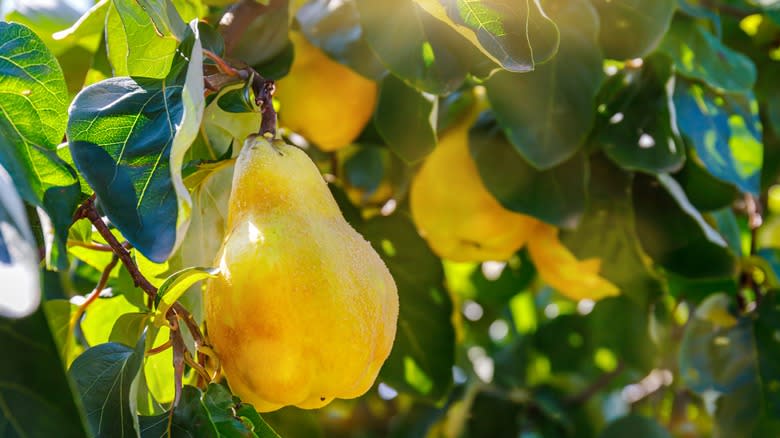
There are many ingredients out there that we just don't use anymore, whether we learned that they were bad for you, there was a disease that wiped out most of a crop, or it simply didn't taste good to most people. Some of these ingredients aren't used for good reason. Numerous studies have shown that trans fats, for example, can increase the risk of heart disease. Some ingredients that are potentially dying out are simply victims of human laziness because they take far too much effort to prepare (especially in a world where, for many of us, seemingly everything is at our fingertips). Some ingredients were simply a product of their time, emerging from food scarcity or war rations, and people don't really have a use for them anymore. Now that so many live in an era where groceries are just a phone tap away, there are dozens of reasons finicky or complicated ingredients might fall by the wayside.
Whatever the cause for their downfall, many of these ingredients have long histories and fascinating backstories. As these ingredients become less and less popular, their stories also threaten to die out. In this article, we have put together a list of 10 ingredients that, for one reason or another, simply aren't used anymore and delve into the fascinating story behind each one.
Read more: US Foods You Surprisingly Can't Find In Canada
Crisco
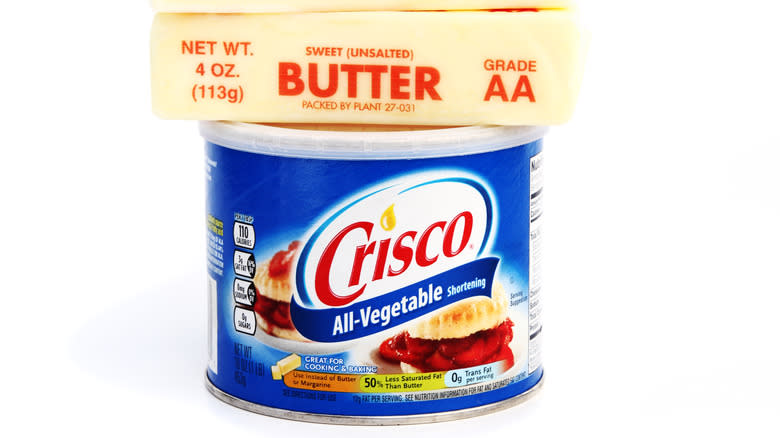
In 1933, Proctor and Gamble published a book titled "Crisco Recipes for the Jewish Housewife" in an effort to, as the title suggests, get Crisco into more Jewish households. It marketed Crisco as a kosher alternative to schmaltz (chicken fat). Advertising Crisco as "healthy, clean, and cheap," this campaign proved hugely successful, and Crisco became a staple in Jewish households and far beyond.
Part of the problem with Crisco is that it used to be made with trans fats (in the form of partially hydrogenated oil). When many studies came out beginning in the '90s that linked trans fat consumption to higher levels of bad cholesterol (and therefore increased risk of heart attacks), many people stopped consuming the ingredient. While Crisco has since removed all of its trans fats, its reputation was tarnished enough that people still associate the brand with the ingredient and its bad reputation.
At the time, big companies conducted their own studies to prove that trans fats weren't actually bad. But, to their dismay, those studies backed up the results of organizations like the Center for Science in the Public Interest. Ultimately, there was no getting around the fact that trans fats are unhealthy. Even in recent studies that look at the new, non-trans-fat version of Crisco, things do not look good for the health reputation of the product. One 2019 study published in Nutrients found that Crisco and other shortenings increased inflammation and the risk of developing fatty liver disease in rats.
Gelatin
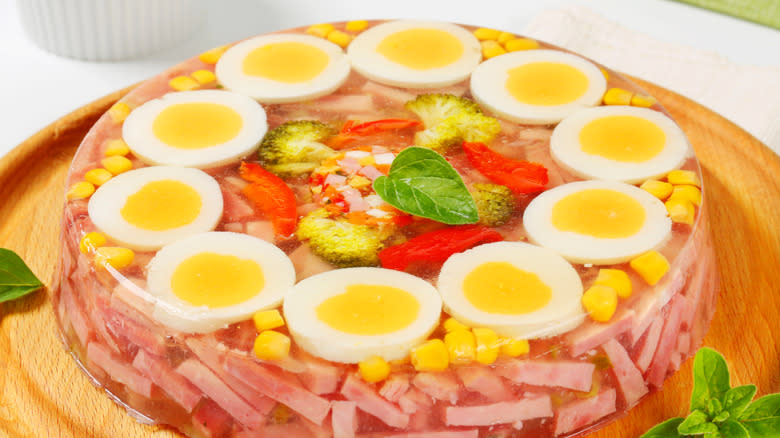
Jell-O salads, aspics, and other forms of gelatin have a long and interesting history. Gelatin dishes go at least as far back as medieval Europe, where they were a sign of wealth and elaborate molds eventually became dining centerpieces for the elite. They fell out of fashion, but had a major resurgence in 1940s and '50s America.
There are two primary reasons for gelatin's big resurgence. It began as a way to encourage home cooks to ration food during WWII, as Jell-O salads and aspics allowed housewives to use up food scraps in creative ways. These dishes were also often a sign of social mobility, allowing cooks to prove that they could still concoct fancy meals despite rationing and nationwide shortages.
By 1968, Jell-O sales were at an all-time high, but then steadily decreased until 1987, when it sold about half as many boxes. "[Gelatin] is one of the very few foods that goes so radically in and out of fashion from epoch to epoch," history professor Ken Albala told Atlas Obscura. "We're in one of those periods where it's totally out of fashion." In the early 2000s, Jell-O tried advertising its products as a low-fat dessert. However, with the fall of the diet culture so prevalent during that era, Jell-O suffered once again, showing its inability to work its way back into American households.
Miracle Whip
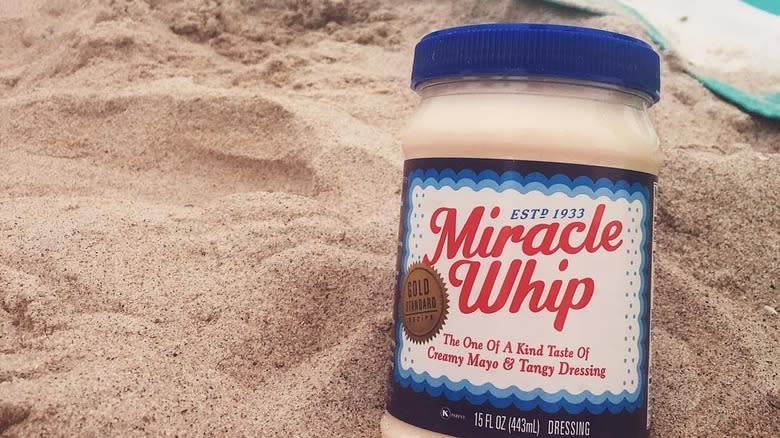
Miracle Whip has been cited by numerous blogs and internet users as the worst "mayonnaise" brand out there. But how did it get to such a low point? Miracle Whip was introduced in 1933 at the World's Fair in Chicago as a scoopable alternative to salad dressing. The condiment was soon considered a competitor to traditional mayonnaise. While it is similar to mayonnaise in terms of color, tangy flavor, and spreadability, Miracle Whip is made with less oil. It is lower in calories and fat than mayonnaise and is made with a wider variety of ingredients, namely sugar, oil, eggs, vinegar, spices, and water.
"It's hard to say if mayonnaise or Miracle Whip is healthier," dietitian Chelsea Edwards told Southern Living. "Mayonnaise is less refined and less processed, which might be more desirable to some people, whereas the lower fat of Miracle Whip may be more important to someone else's nutritional needs." Miracle Whip, like Jell-O, found a foothold in the diet culture that was so prevalent in the 1990s and aughts. However, as people turned more towards natural, less processed products, they also turned away from Miracle Whip, which is largely why so many people are more likely to opt for traditional mayonnaise today.
Margarine
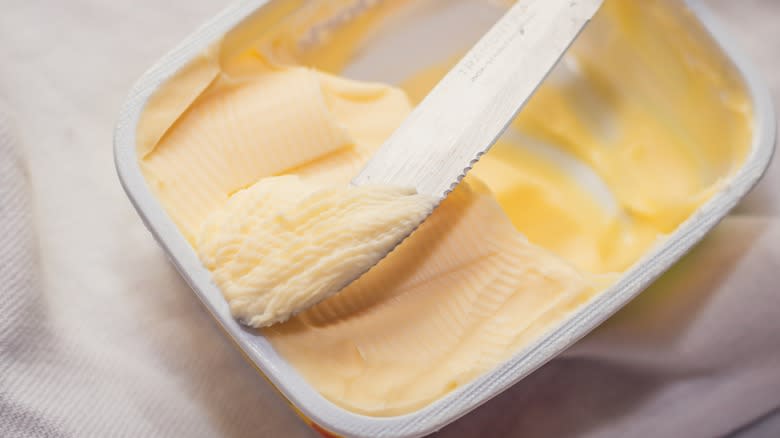
While Crisco is considered to be shortening, margarine lies in a category all its own. There are some similarities between the two, as both products are made with partially hydrogenated vegetable oils and used to be full of trans fats. The main difference is that shortening is always 100% fat, which means that it has a higher melting point. Margarine is heavily diluted and is sometimes as low as 35% fat.
Since the mid-2010s, sales of margarine have been declining, probably because of their association with unhealthy trans fats. Margarine brands like I Can't Believe It's Not Butter used to market themselves as a healthier alternative to butter, which is why they were so successful in the early 2000s when diet culture was arguably more prevalent. When it became clear that margarine wasn't actually better for you, however, consumers increasingly turned back to butter.
It didn't help that, once brands got rid of trans fats in margarine in the early 2010s, many people were still deeply unhappy with the new taste of most margarine brands. "Consumers who were used to a particular taste and expectation may be reacting strongly to any change in their coveted product," a panel of taste testers for Consumer Reports said. Because of this, margarine maker Unilever explored how to get rid of its spreads division altogether.
Gooseberries
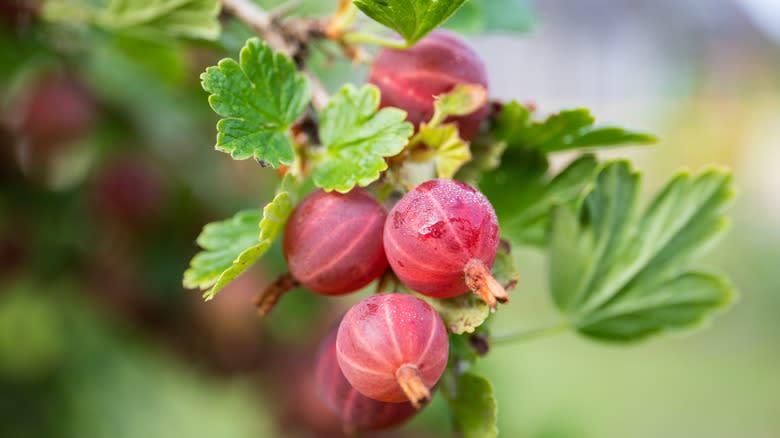
Gooseberries might have just happened to be in the wrong place at the wrong time. It is not necessarily their fault that they aren't eaten anymore, but due to several factors, they are largely absent from our diets today.
Part of the reason that we don't eat gooseberries anymore may be because they are rather sour. More importantly, however, they aren't a popular farm crop. "It's one of the old English fruits that's now in danger of disappearing totally," said farmer Stephen Taylor to The Telegraph. "There has been no investment in gooseberries." Taylor lamented the fact that people can rarely tell the difference between tart gooseberries meant for cooking and sweet dessert gooseberries. That "makes it even more difficult to sell the fruit," he said. Grocery stores are also unwilling to sell gooseberries because their shelf life is so short. Farmers are then all the more unwilling to grow them because they don't sell. It's a sad cycle for the gooseberry.
It doesn't help that gooseberries almost went extinct at the beginning of the 20th century. In the U.S., the fruit was infected with a disease that almost wiped it out. This disease, known as American Gooseberry Mildew, spread to the U.K. and nearly decimated their crop as well. Gooseberries have been farmed less and less ever since. As one of the last U.K. farms committed to growing gooseberries told The Telegraph, "The odds of us growing them in 20 years time is about 50/50 right now."
Thousand Island Dressing
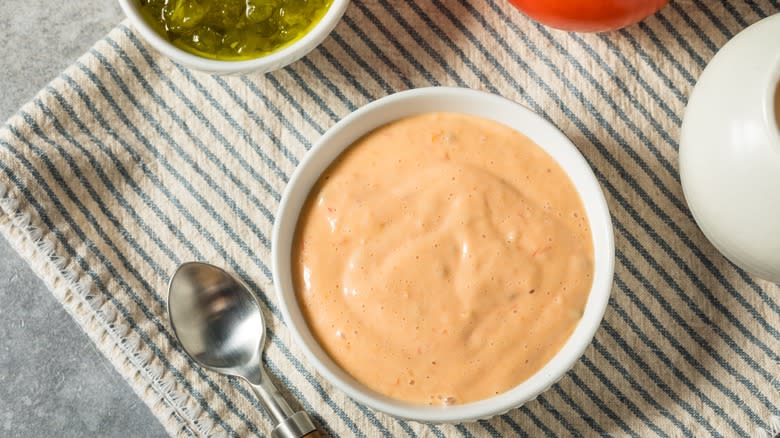
Thousand Island dressing comes from the Thousand Island region of New York (shocker, right?). Thousand Island is a salad dressing that's traditionally very sweet. There are several ways to make Thousand Island, but Mike Simpson, a chef in the Thousand Islands region, makes the dressing with "ketchup, sweet pickle relish, Worcester sauce, mayonnaise, and just a little water for consistency and that's it," as he told WRVO. Even in its homeland, however, Thousand Island dressing just isn't as popular as it once was. Chef Simpson said that the dressing doesn't sell well. Instead, people mostly request the condiment for weddings and other big events. This is likely more because of the novelty of the product, rather than an actual love of the dressing.
Some theories as to why no one wants to eat Thousand Island dressing anymore are pretty simple and focus on the yuck factor. A lot of people don't really love any one particular salad dressing, but there are plenty that they hate, and Thousand Island dressing is one of them.
However, while this theory might hold a grain of truth, the answer is probably much more simple. Back when Thousand Island dressing was invented, salads were often made with markedly bitter greens like chicory and endive. Mayonnaise and the sugar in ketchup helped cut through the taste of these greens. Since diners are more likely to want milder greens, fewer people want to eat a salad dressing that's as sweet as Thousand Island anymore.
Iceberg Lettuce
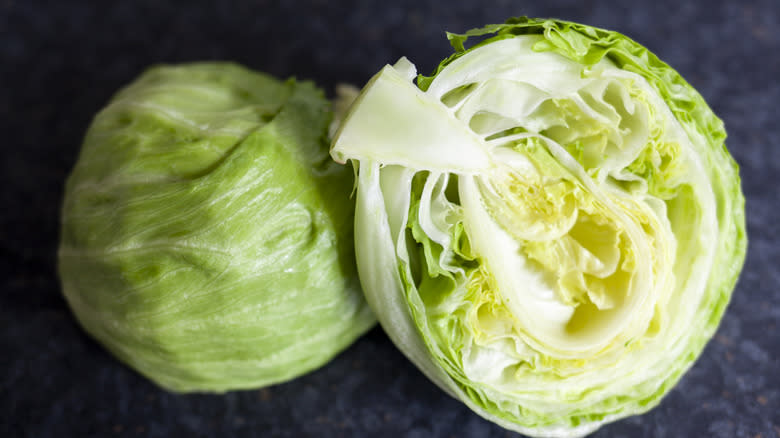
Another ingredient that Americans have just lost interest in is iceberg lettuce. According to the USDA Economic Research Service, iceberg lettuce consumption was steadily decreasing while romaine lettuce consumption was on the rise until 2020 (via Bloomberg). That is the year the two ingredients crossed paths, and now it is very likely that romaine has surpassed iceberg lettuce in popularity.
The big change occurred in the late '80s when Fresh Express, a lettuce grower based in California, figured out how to preserve and maintain the freshness of pre-cut, pre-washed, bagged salads. Before this, iceberg lettuce was the easiest to transport and store. Now, the possibilities are nigh on endless, with tastier and more nutritious greens easily found in your local grocery store in plastic, pre-washed tubs.
Iceberg may have retained its popularity if people actually liked it, but as it turns out, that was never exactly the case. Restaurateur Alice Waters wrote about her distaste for the vegetable in the San Francisco Chronicle (via Taste), writing, "It is omnipresent ... It doesn't have a season. It doesn't have a sense of place." An opinion columnist for VICE wrote that the vegetable "tastes like solidified water — which, yes, is ice. Its fault lies in its name! It's filler lettuce with virtually no nutritional value." Ouch. Sorry, iceberg lettuce, but it looks like your time may be over.
Turnips
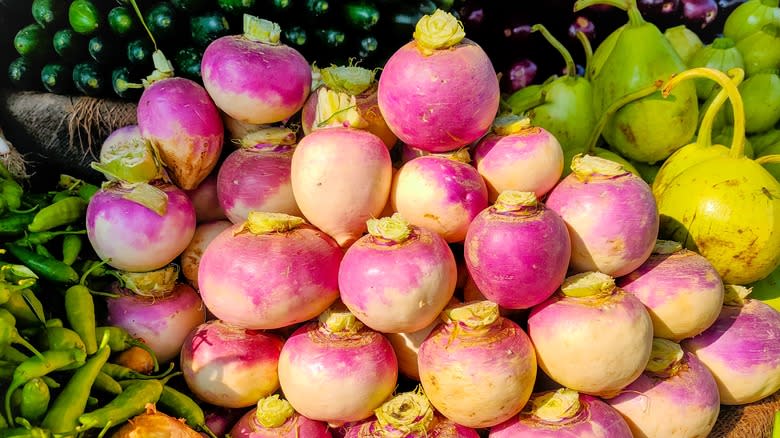
They have a long and winding history, having grown wild throughout Europe thousands of years ago. They were a Roman favorite and were regarded as one of the most important vegetables around until the 1st century. Yet, though they were once esteemed for their healthfulness and versatility, turnips have lost much of their popularity in recent generations.
According to a survey conducted on behalf of VeggieTracker, turnips are the most hated vegetable in America, with 27% of respondents saying that they dislike the vegetable (via Fox News). This hatred probably has more to do with the fact that turnips are rarely eaten anymore, and therefore more likely to be severely misunderstood.
While turnips were a beloved vegetable thousands of years ago, over time, this slightly spicy member of the mustard family became food for the poor and livestock. Turnips have also been a last resort during many wars and times of food insecurity. During World War I, German civilians were forced to replace their bread and potatoes with turnips due to food shortages. During World War II, British citizens also ate more turnips than they may have liked. To many diners, this association with poverty and dire times remains to this day and contributes to the vegetables' unpopularity.
In recent times, people have also turned to easier-to-use and more common root vegetables, like potatoes and carrots. With all of these historical aspects combined, it makes sense that the turnip so often lies forgotten.
Quince
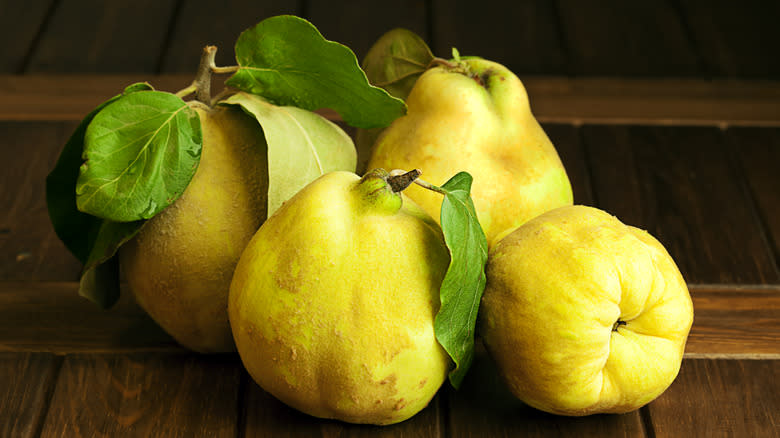
The quince is a unique fruit, looking like a combination between an apple and a pear but with its own flavor profile, which is often described as slightly citrusy, but far more mellow than biting into a lime or lemon. It cannot be eaten raw, but once it's been cooked, quince tastes great in jams, compotes, cakes, and more. The fact that it needs to be cooked down probably has something to do with its unpopularity. This is part of the reason that gooseberries are unpopular;l, too, as people simply don't reach for fruits that are either too sour or require much extra work to enjoy. That said, quince used to be much more popular than it is today.
The history of the quince goes back to the Silk Road, which is how the fruit, which is native to the Caucasus Mountains, became popular throughout Europe. Once traders began to bring the fruit throughout Europe, it quickly gained popularity. Tales of its medicinal powers surrounded the unique fruit; one Roman naturalist even claimed that quinces could ward off the evil eye.
Until the Middle Ages, quinces were more widespread than apples. They were deeply valued at the tables of the wealthy, royal, and aristocratic, who served quinces as delicacies in an attempt to show off their greatness. By the 20th century, however, quinces had lost much of their power and allure. Without servants to do much of the prep work, wealthy people realized that quinces were much more trouble than they were worth.
Acorn Flour
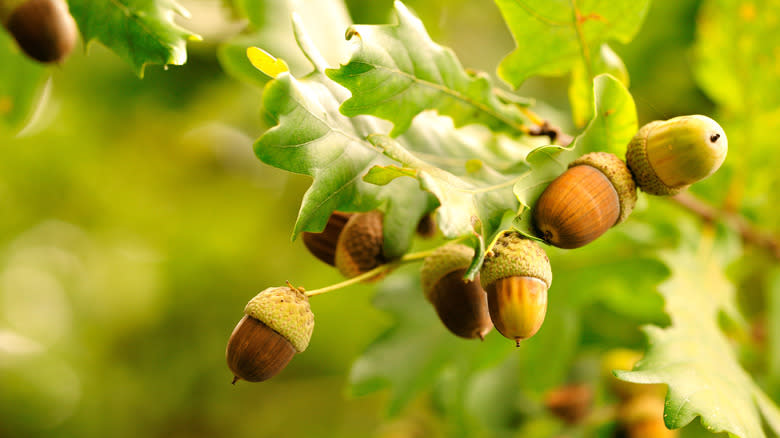
Acorn flour is an ingredient that used to be incredibly important on the American continent and was also once prevalent in Europe. It was used by Native Americans, to the point where some tribes cultivated huge forests for agricultural use. The Acjachemen Nation, for example, would eat acorns in a sort of mish called wiiwish, "similar to Cream of Wheat or Malt-O-Meal, and it would be served hot with every meal," according to Heidi Lucero, a member of the tribe. Lucero spoke to KCRW about the use of acorns in Native cooking, explaining that acorns were first roasted, and then ground into a meal.
Acorns were also eaten during the Middle Ages in Europe. While the nuts were primarily used as food for livestock by the time the medieval period rolled around, they were also deployed as an emergency source of food for people. Medieval Europeans would dry acorns and grind them into flour, then use this flour to make bread, especially during periods of scarcity such as war, famine, or poor harvests.
While it makes sense that Europeans stopped eating acorns, considering it was never a staple food and the nuts were difficult to work with, the reason that the ingredient isn't common in America is due to European colonization. American oak forests grown and tended by indigenous people were cut down by colonizers looking to clear land. Over the years, many aspects of Native culture were suppressed, including the use of acorns in the everyday diet.
Read the original article on Mashed.

